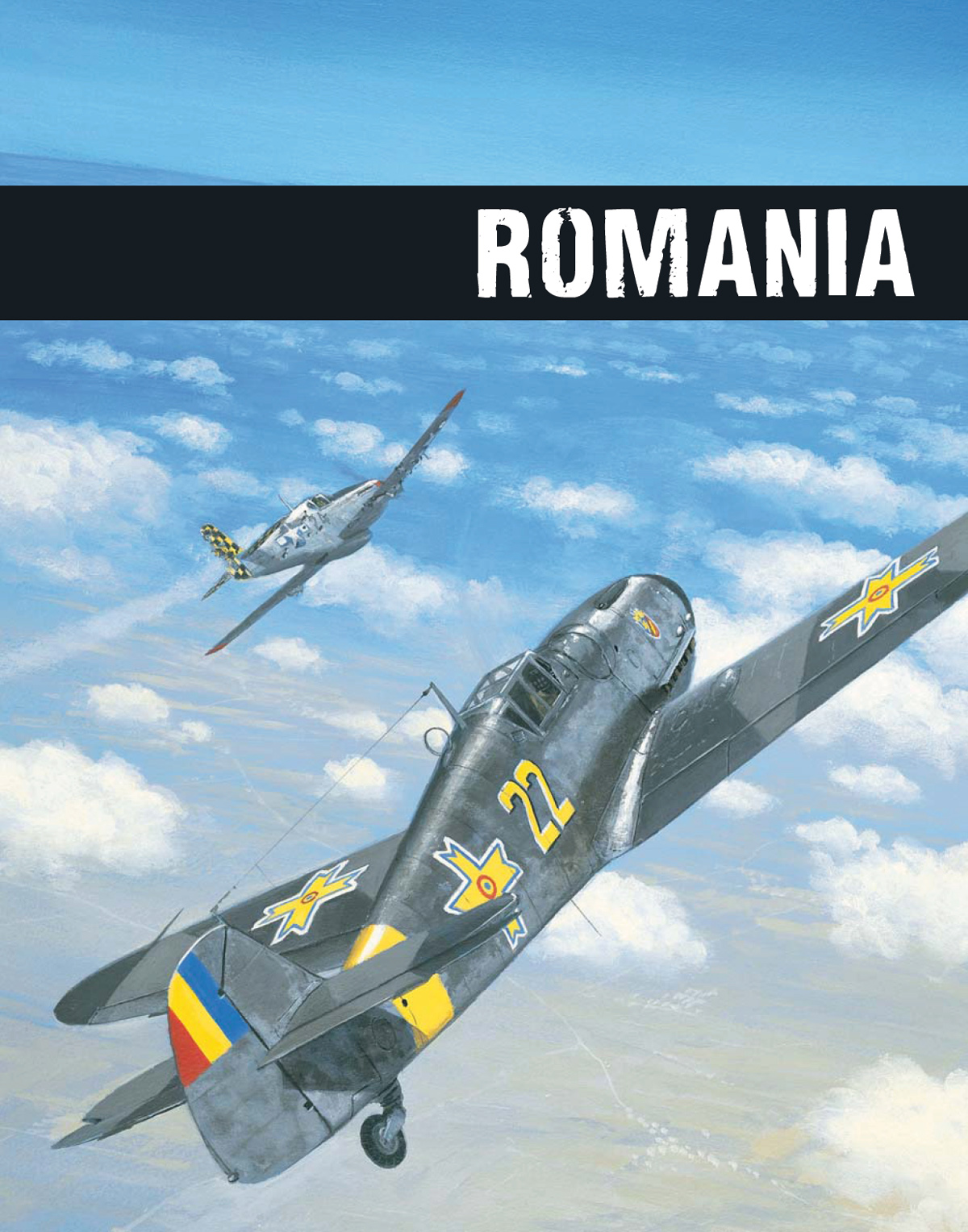

Romanian Bf 109G, by Mark Postlethwaite © Osprey Publishing Ltd. Taken from Aircraft of the Aces 54: Rumanian Aces of World War 2.
The fall of France in 1940 had a major impact on the political and military future of Romania. The traditional alliance with France and Great Britain came into question in the face of real and immediate demonstrations of both German and Soviet power.
The Romanian oilfields were of great importance to Nazi Germany, and critical to the operation of the Axis war machine. Preserving access to this resource was of prime importance. In June of 1940, the Soviet Union issued an ultimatum to the Romanian government that was to result in Romania surrendering the territories of Bessarabia, Northern Bukovina, and Hertza to the Soviets. This Soviet threat to the oil fields convinced Hitler that, one way or the other, Romania must be secured.
Fortunately for Germany, anti-communist General Ion Antonescu came to power due to popular dissatisfaction with the seemingly impotent French and British Allies. As Antonescu’s power was progressively consolidated, the drumbeat to war against the Soviet Union grew louder.
When Hitler finally decided to go to war with Russia, Romania was key to his plans. A large number of Romanian troops were involved in Operation Barbarossa and the Romanian Army loyally supported the Axis cause as they pushed through the Crimea as far as Stalingrad. Stalingrad was a major defeat for the Romanians, and a general retreat followed through the Caucasus.
At the outbreak of the war, the Romanians possessed 19 front line infantry divisions. The Romanian infantry division was similar to the German in that it contained three infantry regiments, two artillery regiments, a pioneer battalion, an antitank company and a partially motorized reconnaissance group. The artillery was not fully equipped with modern weaponry, which lessened the Romanian combat strength relative to their German allies.
Germany’s attack on Stalingrad relied heavily on the help of Romanian forces protecting the Axis forces from encirclement. This secondary, but crucial role, meant that most heavy equipment was dedicated to the assault on the city, leaving the Romanians under-gunned.
The winter of 1942–43 brought attack after attack from the Soviets, attempting to break through the Romanian lines and encircle the forces besieging Stalingrad. Lacking enough anti-tank assets to address the forces aligned against them, Romanian troops often resorted to close-up fighting against the Soviet armour, throwing anti-tank grenades and anything else they could get their hands on against the oncoming armoured vehicles. Fighting against Soviet Guards units often ended in hand-to-hand combat, neither side giving ground. In less than three months, the Romanians would lose over 150,000 men in and around Stalingrad, essentially losing all ability to launch an effective attack for the rest of the war.
As the war progressed, the infantry underwent several reorganizations and upgrades to equipment, affording the Bolt Action commander further options in assembling a force: PPSh sub-machine guns, Panzerfausts, MG34s, Mosin Nagant 1891/30s, PaK 97/38s and so on.
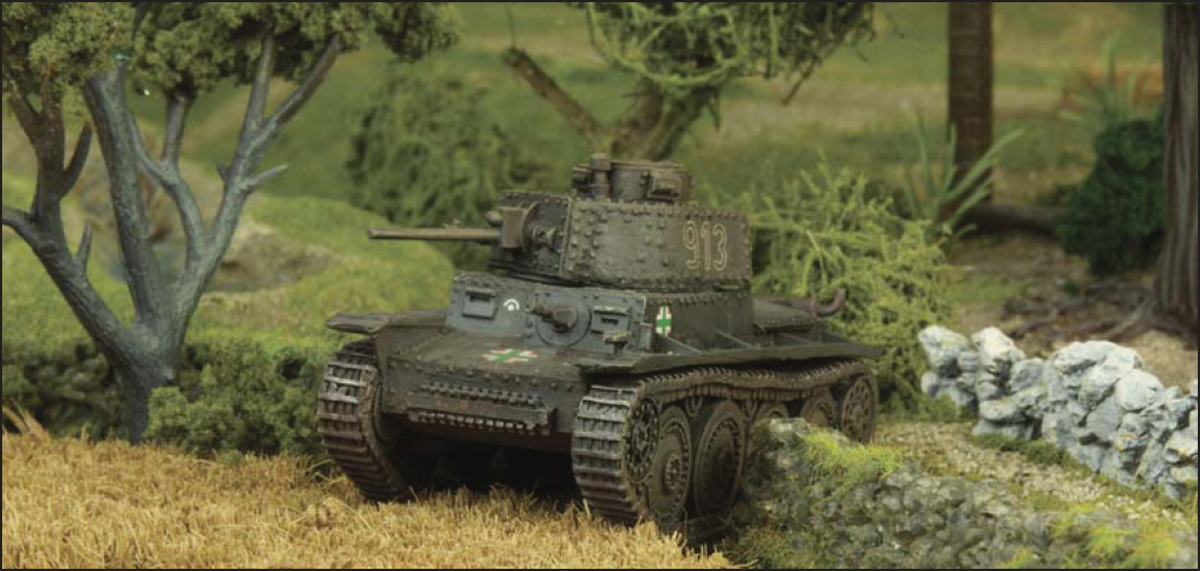
Czech-designed, German-captured and now in Romanian service, a Panzer 38(t) rumbles cross-country
This is the official Bolt Action Army List for the forces of Romania. Players can pick an army in either of two ways.
• Use the Reinforced Platoon selector from the Bolt Action rulebook in conjunction with the Army List in this book. To save referencing back to the rulebook, the generic Reinforced Platoon selector is repeated below.
• Instead of using the generic Reinforced Platoon selector, use any one of the theatre selectors on page 93-96 in conjunction with the Army List given in this book.
Either method is perfectly acceptable depending on what kind of game you wish to play. The first method uses the generic selector and is more flexible and therefore ideal for pick-up games against any opponent, as it allows for a wider variety of different kinds of troops and equipment. The second method, using the theatre selectors, is more historically representative and therefore better suited for games where a historical portrayal is envisaged. We imagine that players will, on the whole, prefer to fight battles within a specific historical context, in which case simply use the appropriate theatre selector to choose your army.
1 Lieutenant – First or Second
2 Infantry squads
plus:
0–3 Infantry squads
0–1 Captain or Major
0–1 Medic
0–1 Forward Observer (either Artillery or Air)
0–1 Machine gun team
0–1 Mortar team
0–1 Sniper team
0–1 Anti-tank team
0–1 Field Artillery, Anti-aircraft or Anti-tank gun
0–1 Armoured Car
0–1 Tank or Tank Destroyer
0–1 Transport vehicles or tow (soft-skins or armoured) per infantry and artillery unit in the Reinforced Platoon
Romanian forces operated in close support of German forces and thus were often ‘stiffened’ by German units.
To represent this, a Romanian force may include one extra unit from either the German list in the Bolt Action rulebook, or the Armies of Germany book, or the Italian Eastern Front theatre selector from this book (though no Italian army special rules apply). This unit does not count towards the normal platoon maximum, but it cannot be a Veteran unit, and cannot be a vehicle with a Damage Value of 10+ or 11+.
Like many armies of Europe, the Romanians modelled their armed forces on many French concepts. French artillery doctrine called for artillery to be deployed close to the front line, where it could react quickly to an enemy’s actions.
Romanian armies get one free Inexperienced or Regular artillery unit. This unit can be any anti-tank gun or field artillery piece in the Romanian army list (except for heavy artillery and German artillery). This unit is in addition to the number of artillery units normally available.
The list is divided into categories as follows:
| 1 Infantry | Headquarters units Infantry sections and teams |
| 2 Artillery | Field artillery Anti-tank guns Anti-aircraft guns |
| 3 Vehicles | Tanks Tank destroyers Transports and tows |
The Romanian infantry division was organized in the classic ‘triangle formation’ – 3 regiments, of 3 battalions, with 3 companies, with 3 platoons, with 3 squads. The officers in charge ranged from experienced veterans early in the war to raw recruits near the end. A mix of equipment, especially in the later periods of the war, is the norm.
At the start of the war, the Romanian Army possessed many officers who were veterans of World War I. As the war with the Soviet Union dragged on, replacements were rushed into service as the situation demanded.
Cost: Second Lieutenant 35pts (Inexperienced), 50pts (Regular), 65pts (Veteran)
First Lieutenant 60pts (Inexperienced), 75pts (Regular), 90pts (Veteran)
Captain 95pts (Inexperienced), 110pts (Regular), 125pts (Veteran)
Major 135pts (Inexperienced), 150pts (Regular), 165pts (Veteran)
Team: 1 officer and up to 2 further men
Weapons: Pistol, sub-machine gun, or rifle as depicted on the models
Options:
• The officer may be accompanied by up to 2 men at a cost of +7pts per man (Inexperienced), +10pts per man (Regular), or +13pts per man (Veteran)
Medical advances between the wars allowed all nations to see the importance of highly skilled men made available to frontline troops. The vast majority of wounded men treated very soon after being wounded survived their injuries. Trained medics, stretcher-bearers and other troops were dedicated to these medical tasks.
Cost: 30pts (Veteran)
Team: 1 medic and up to 2 further men
Weapons: Pistol or none as depicted on the model
Options:
• The medic may be accompanied by up to 2 men at a cost of +13pts per man (Veteran)
Like most armies of the time, the Romanians learned the power of artillery during World War I and continued to take advantage of modern communications to establish the Forward Observer. This arrangement made for quickly available firepower for both attack and defence.
Cost: Artillery Forward Observer 100pts (Regular), 115pts (Veteran)
Team: 1 Forward Observer and up to 2 further men
Weapons: Pistol, sub-machine gun, or rifle as depicted on the models
Options:
• The observer may be accompanied by up to 2 men at a cost of +10pts per man (Regular) or +13pts per man (Veteran)
The Romanian soldier was outfitted with the Czech vz. 24 carbine rifle, modelled closely on the Mauser Gewehr 98. Each section was also regularly equipped with the ZB vz. 26 light machine gun or its later evolution, the ZB 30. This is very similar to the British Bren and is sometimes referred to as such, although it was a different weapon. The Romanian Army provided more troops than all other German allies combined for the attack against the Soviet Union. While possessing large numbers of troops, there is debate over how the units actually performed during the war. There seems to be general agreement that the harsh criticisms offered by their German allies were partially motivated to deflect blame for their own failure to defeat the Soviet Union.
Cost: 73pts (Regular)
Composition: 1 NCO and 6 men
Weapons: The NCO is armed with an SMG, all others with rifles
Options:
• Add up to 7 additional men with rifles at +10pts each
• One soldier may have a light machine gun for +20pts – another soldier becomes the loader
• Equip the NCO with a rifle for –3pts
• Equip the entire unit with anti-tank grenades for +2pts per man
Special Rules:
• Tank Hunters if unit equipped with anti-tank grenades
As the war continued, the influx of more and varied equipment was felt by the infantry. Though constantly waiting in line behind the Wehrmacht, German and captured Russian equipment did start to flow to the new recruit and the battle-hardened veteran alike. The Romanians fought bravely at Stalingrad and gained valuable but hard-fought experience on the long retreat through western Russia.
Cost: 73pts (Regular), 94pts (Veteran)
Composition: 1 NCO and 6 men
Weapons: The NCO is armed with an SMG, all others with rifles
Options:
• Add up to 7 additional men with rifles at +10pts each (Regular) or +13pts each (Veteran)
• One soldier may have a light machine gun for +20pts – another soldier becomes the loader
• Equip the NCO with a rifle for -3pts
• Equip up to 3 additional soldiers with an SMG for +3pts each
• Arm 1 soldier with a Panzerfaust for +10pts
• Equip the entire unit with anti-tank grenades for +2pts per man
Special Rules:
• Tank Hunters if unit equipped with anti-tank grenades or Panzerfaust
After the end of World War I, the Romanian Army continued to modernize its cavalry formations. Cavalry changed into mounted infantry to provide a more mobile and faster reaction force; the days of the cavalry charge were mostly a faded memory of a heroic unit history. Still, the mystique and élan of the cavalry formation showed itself in the fact that the Germans awarded 5 Knight’s Crosses to Romanian cavalry officers during the war. These formations were particularly brave in the battle of Stalingrad, where Ioan Hristea’s 2nd Cavalry Regiment covered the retreat of the Romanian Fourth Army, earning him a Knight’s Cross.
Cost: 72pts (Regular), 90pts (Veteran)
Composition: 1 NCO and 5 men mounted on horses
Weapons: Rifles
Options:
• Add up to 7 additional horse-mounted soldiers for +12pts each (Regular) or +15pts each (Veteran)
• Equip one soldier with a Panzerfaust for +10pts
Special Rules:
• The Romanian cavalry was not trained to charge into battle, but rather acted as a mobile reserve, or pursuit unit. Romanian cavalry units may move into contact with an enemy unit while mounted. On the other hand, Romanian cavalry sections do not suffer the -1 to their leadership roll to arrive from reserve
• Tank Hunters if unit equipped with a Panzerfaust. Note: the Panzerfaust may not be fired while mounted
Motorized transport was in short supply to all combatants, and the Romanians were no exception, with the Ford, Praga, Skoda and Opel trucks in very short supply. On paper, the goal was to have one motorized regiment per three in the cavalry, though this was all too often not realized.
Cost: 53pts (Regular), 68pts (Veteran)
Composition: 1 NCO and 4 men
Weapons: The NCO is armed with an SMG, all others with rifles
Options:
• Add up to 5 additional men with rifles at +10pts each (Regular) or +13pts each (Veteran)
• Up to 2 soldiers may have a light machine gun for +20pts each – another soldier becomes a loader for each of the machine guns purchased
• Equip the NCO with a rifle for -3pts
• Arm one soldier with a Panzerfaust for +10pts
Special Rules:
• Tank Hunters if unit equipped with a Panzerfaust
Romanian forces were primarily equipped with Czech-made machine guns. The tripod-mounted ZB 53 of 1937 was used in a medium machine gun role, as were World War I-vintage Schwartzlose and Maxim type weapons. Later, German MG34s were made available to the Romanian forces in limited numbers.
Cost: 35pts (Inexperienced), 50pts (Regular), 65pts (Veteran)
Team: 3 men
Weapon: 1 MMG
Special Rules:
• Team weapon
• Fixed
• German machine gun: roll one extra shot when firing the MMG
Though Germany made Panzerschrecks available to its allies, and did export them in significant numbers, historical accounts of Romanian usage of the weapon are spotty at best. There is plenty of photographic evidence of Romanian soldiers marching with and training with the weapons, but accounts of their usage are somewhat few and far between. Nevertheless, it is clear the Romanian army was issued the weapon, and it is entirely likely that the weapons were employed against Soviet armour.
Cost: 56pts (Inexperienced), 80pts (Regular), 104pts (Veteran)
Team: 2 men
Weapon: 1 Panzerschreck
Special Rules:
• Team weapon
• Shaped charge
The Romanian army used a number of captured weapons during the war. The Russian 7.62mm Mosin Nagant model 1891/30 was popular with the Russian soldiers, and a modified version became the standard sniper weapon in the Romanian army.
Cost: 50pts (Regular), 65pts (Veteran)
Team: 2 men
Weapons: Rifle
Special Rules:
• Team weapon
• Sniper
After the fall of France, large quantities of 60mm mortars were provided to the Romanians in time for a 1942 offensive against the Soviet Union. The 60mm, a weapon that barring a few modifications is still in use today, was highly mobile and accurate. Consisting of a smooth bore tube, bipod stand, and a base plate, the mortar was simple to operate and produce. Before receiving the captured tubes, Romania had actually purchased the licensing rights to manufacture the mortar for itself. As a company-level support weapon, Romanian infantry could count on fire support from the reliable 60mm.
Cost: 24pts (Inexperienced), 35pts (Regular), 46pts (Veteran)
Team: 2 men
Weapon: 1 light mortar
Special Rules:
• Team weapon
• Indirect fire
• HE (D3)
Like most medium mortars in use by European nations in World War II, the Romanians used a French-designed 81mm Brandt medium mortar. The Brandt mortar was easy to manufacture, easy to carry, and was relatively accurate. The weapon could be quickly broken down into three loads and carried by the crew to new firing positions, where assembly was equally quick.
Cost: 35pts (Inexperienced), 50pts (Regular), 65pts (Veteran)
Team: 3 men
Weapon: 1 medium mortar
Options:
• May add Spotter for +10pts
Special Rules:
• Team weapon
• Fixed
• Indirect fire
• HE (D6)
Early in the war, Romanian forces captured numerous 120mm heavy mortars from the Soviet armies, and put them to use. These captured weapons dramatically increased Romania’s artillery capabilities, and thus it was not long before an unlicensed copy was produced under the name Resita Model 1942.
Cost: 46pts (Inexperienced), 65pts (Regular), 84pts (Veteran)
Team: 3 men
Weapon: 1 medium mortar
Options:
• May add Spotter for +10pts
Special Rules:
• Team weapon
• Fixed
• Indirect fire
• HE (2D6)
Romania provided more manpower in the war on the Eastern Front than any other minor Axis power. At the launch of Operation Barbarossa, Romanian soldiers made up several entire armies of the plan’s Army Group South. In little over three weeks, these several hundred thousand Romanian fighters took back territories lost to the Soviet Union only a year before, in the form of Bessarabia and Northern Bukovina. Army Group South was truly a multinational force, consisting of troops from Germany, Romania, Hungary, Italy, and Slovakia, but the Romanian soldier truly made a name for himself throughout the vicious fighting of the East. By the end of their involvement with the Axis powers, they were actively engaged in non-stop combat with the Soviet Union from Barbarossa until August of 1944.
Most Romanian light artillery comprised World War I-vintage field guns and mountain guns of 75mm calibre. Captured Russian artillery also became available as the Romanians advanced eastwards. At the start of the war, the Romanian arsenal included the usual mix of Schneider, Krupp and Skoda weapons found in other European armies. The Romanians also had a number of captured World War I Russian Putilov guns fitted with 75mm barrels (from 76mm). These Schneider-Putilov 1902/36 guns equipped the artillery regiments of the infantry divisions.
Cost: 40pts (Inexperienced), 50pts (Regular), 60pts (Veteran)
Team: 3 men
Weapons: 1 light howitzer
Options:
• May add Spotter for +10pts
Special Rules:
• Gun shield
• Team weapon
• Fixed
• Howitzer
• HE (D6)
The bulk of Romania’s artillery was comprised of several marks of Skoda 100mm howitzers, as well as Krupp and Schneider weapons of 105mm calibre. The 100mm Skoda 1916 and 105mm Skoda and Bohler of 1939 and 1940 respectively were lightly constructed mountain guns, which offered some semblance of mobility at the cost of range and destructive power. Horse-drawn batteries were well trained in rapid redeployment, offering fire support at a moment’s notice.
Cost: 60pts (Inexperienced), 75pts (Regular), 90pts (Veteran)
Team: 4 men
Weapons: 1 medium howitzer
Options:
• May add Spotter for +10pts
Special Rules:
• Gun shield
• Team weapon
• Fixed
• Howitzer
• HE (2D6)
Romanian heavy artillery relied mostly on World War I Skodas and Schneiders of 155mm calibre, together with a number of Skoda 150mm field howitzers.
Cost: 92pts (Irregular), 115pts (Regular), 138pts (Veteran)
Team: 5 men
Weapon: 1 heavy howitzer
Options:
• May add Spotter for +10pts
Special Rules:
• Gun shield
• Team weapon
• Fixed
• Howitzer
• HE (3D6)
The Romanians used a number of different light anti-tank guns throughout the war. Many of them were German or Italian. Though these light anti-tank guns were rarely a match for the best Soviet armour, they provided the infantry with some much-needed direct anti-tank capability. The French Puteaux 25mm M37, German PaK 36, Italian 47/32, Bofors 37mm, Schneider 47mm, Breda, Bohler and more guns were utilized. Any of these guns can appear in a Romanian army.
Cost: 36pts (Inexperienced), 45pts (Regular), 54pts (Veteran)
Crew: 2 men
Weapon: 1 light anti-tank gun
Options:
• Purchase a gun shield for +5pts
Special Rules:
• Team weapon
• Fixed
• Gun shield (if purchased)
When the Germans ran headfirst into Soviet tanks during Operation Barbarossa, it was clear that better anti-tank weapons were needed. Fortunately, thousands of French 75mm guns were captured during the Blitzkrieg, and these could be easily converted to an anti-tank role. The 75mm barrel was mounted on the PaK 38 (5cm) chassis, and a huge muzzle brake was installed to reduce recoil. Many of these guns were given to Germany’s allies including the Finns, Italians, Hungarians and Romanians. Romania also received many unmodified PaK 38s – this entry can be used for that gun as well.
Cost: 60pts (Inexperienced), 75pts (Regular), 90pts (Veteran)
Team: 3 men
Weapon: 1 medium anti-tank gun
Special Rules:
• Team weapon
• Fixed
• Gun shield
The 75mm TAC anti-tank gun was designed by the Resita to give the Romanian army a purpose-built anti-tank gun. Marrying the chassis design of the Soviet 76mm with the gun design of the German PaK 40 gave the Romanians some much-needed punch to face the Soviet (and later German) tanks of the time.
Cost: 88pts (Inexperienced), 110pts (Regular), 132pts (Veteran)
Crew: 4 men
Weapon: 1 heavy anti-tank gun
Special Rules:
• Team weapon
• Fixed
• Gun shield
The German-made 20mm Flak 38 was the mainstay of Romanian air defence, but the Romanians also had a good selection of other, heavier anti-aircraft guns.
Cost: 40pts (Inexperienced), 50pts (Regular), 60pts (Veteran)
Team: 3 men
Weapon: 1 light automatic cannon
Options:
• Upgrade the light automatic cannon to a heavy automatic cannon for +10pts
Special Rules:
• Team weapon
• Fixed
• Flak
The Romanians utilized captured R35 tanks on the front lines until well into 1944, much later than most nations. The French R35 was well armoured, but suffered from a poor main gun and a low top speed.
Cost: 124pts (Inexperienced), 155pts (Regular)
Weapons: 1 turret-mounted low-velocity light anti-tank gun
Damage Value: 8+ (light tank)
Special Rules:
• 1-man turret: combining the roles of commander, gunner and loader in together and squeezing the man responsible into a tiny 1-man turret means it’s hard to do different things at once! To represent this it is always necessary to make an order test when issuing an Advance order, even if the tank is not pinned
• Armoured all round: the R35 was almost as heavily armoured at the sides and rear as at the front, so no modifiers apply for penetration when shooting at the sides, rear or from above. All shots count the full armour value
• Low velocity light anti-tank gun: the R35’s puny weapon counts as a light anti-tank gun but with an armour penetration rating of +3 instead of the usual +4
• Slow
The Romanians captured large numbers of Soviet T-60s and 76.2mm guns in 1941 and 1942. Simultaneously, Romanian command realized there was a dire need for mobile anti-tank guns to deal with Soviet armour. Combining the T-60 and 76.2mm gun was feasible, inexpensive, and maintainable, and so almost three dozen vehicles were converted to this task. An armoured fighting compartment for the crew was constructed around the chassis of the T-60, offering some semblance of protection.
Cost: 92pts (Inexperienced), 115pts (Regular), 138pts (Veteran)
Weapons: 1 hull-mounted medium anti-tank gun
Damage Value: 7+ (tankette)
Special Rules:
• Open-topped
Like most European militaries that were scrambling to mechanize in the face of modern warfare, the Romanians had a wide variety of trucks in service. Praga RVs, Skoda, Lancia, Mercedes, and even Ford are just a few of the manufacturers whose trucks would serve in the Romanian armed forces.
Cost: 31pts (Inexperienced), 39pts (Regular), 47pts (Veteran)
Weapons: None
Damage Value: 6+ (soft skin)
Transport: 12 men
Tow: Light howitzer, light or medium anti-tank gun, light anti-aircraft gun
Several wheeled artillery tractors were in use with the Romanian army.
Cost: 12pts (Inexperienced), 15pts (Regular), 18pts (Veteran)
Weapons: None
Damage Value: 6+ (soft skin)
Tow: Any howitzer; any anti-tank gun, any anti-aircraft gun
The following theatre selectors cover the main engagements of the Romanian forces in World War II.
After losing large tracts of territory due to unfavourable treaties in 1940, Romania’s government was replaced with a fascist, pro-war government that was eager to join the Germans for Operation Barbarossa. Romania committed more troops to assist the Germans on the Eastern Front than any of Germany’s other allies combined. The Romanian army suffered severe losses at Stalingrad, which began a brief era of political uncertainty. The losses combined with Romania becoming a target of Allied bombing, and the growing belief that the tides were turning against the Axis eventually led to a coup that saw a nation divided.
As Soviet armies entered Romania, the remaining pro-German forces were quickly swept aside. In August of 1944 Romania officially declared war against Germany and, perhaps more importantly, her longtime rival Hungary. Romanian and Soviet forces swept into Hungary and laid siege to Budapest, eventually capturing the city and fighting the Wehrmacht until the war’s end.
Before playing a game, the players must decide the theatre selector from which they will pick their reinforced platoon. If they wish, opponents can ‘match up’ their armies so that they are contemporary with each other. To give an example, a Romanian force would be well matched against any early and mid-war Soviet force.
Obviously, there is nothing to stop players fighting battles between forces from different periods and theatres. Whilst not historically accurate, players often like to try ‘what if’ type games. The points values will ensure that such a game of Bolt Action is fairly evenly balanced, but don’t be surprised if you have trouble penetrating the armour of late-war super heavy tanks.
Romanian units fought alongside German forces at all of the major engagements in southern Russia. Time and time again the Romanian forces proved themselves on the field of battle, and were instrumental in many key successes.
A Romanian force for Onward to the Caucasus! must comprise one or more Reinforced Platoons picked from the following theatre selector. Each Reinforced Platoon is made up as follows:
1 Lieutenant – First or Second
2 Infantry sections – Early War infantry, Motorized infantry
Plus:
Headquarters
0–1 Captain or Major
0–1 Medic team
0–1 Forward Observer (Artillery)
Infantry
0–4 Infantry sections: Early War infantry, Motorized infantry, Cavalry
0–1 Machine gun team
0–1 Sniper team
0–1 Mortar team: light or medium
Artillery
0–1 gun from:
Anti-tank gun: light anti-tank gun, 7.5cm PaK 97/38
Field artillery: light artillery, medium artillery, heavy artillery
Anti-aircraft gun: light or heavy automatic cannon
Armoured Cars and Recce Vehicles
0–1 vehicle from: SdKfz 222 or 223
Tanks and Tank Destroyers
0–1 vehicle from: Panzer 35(t), Panzer 38(t), Panzer III N, Panzer IV E or F, Tacam tank destroyer, captured Renault R35
Transports and Tows
0–1 transport vehicle per infantry unit in the Reinforced Platoon: miscellaneous trucks
0–1 tow: artillery tractor
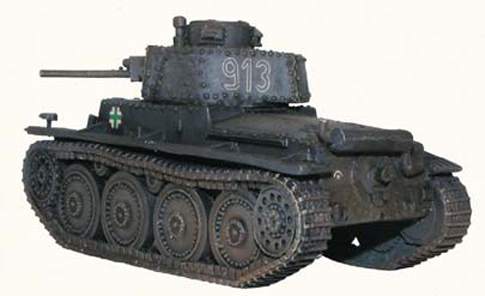
Romanian Panzer 38(t)
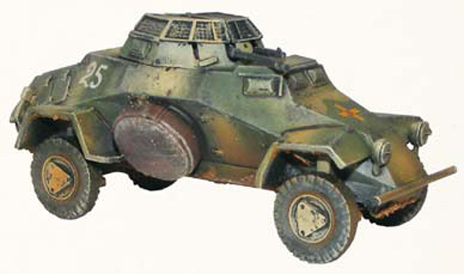
Romanian SdKfz 222 armoured car
• Axis Vehicles in Romanian Service: The Germans provided the Romanian army with many left over armoured fighting vehicles, significantly bolstering the Romanian armoured forces. You may use any of the following vehicles from either the Armies of Germany book or the Bolt Action main rulebook. These vehicles may be purchased at any of the training levels available to the Germans.
• Tanks: Panzer 35(t) or Panzer 38(t), Panzer III N, Panzer IV E, F, G, or H, StuG III G, Panther A or G
• Armoured Cars: SdKfz 222, SdKfz 223
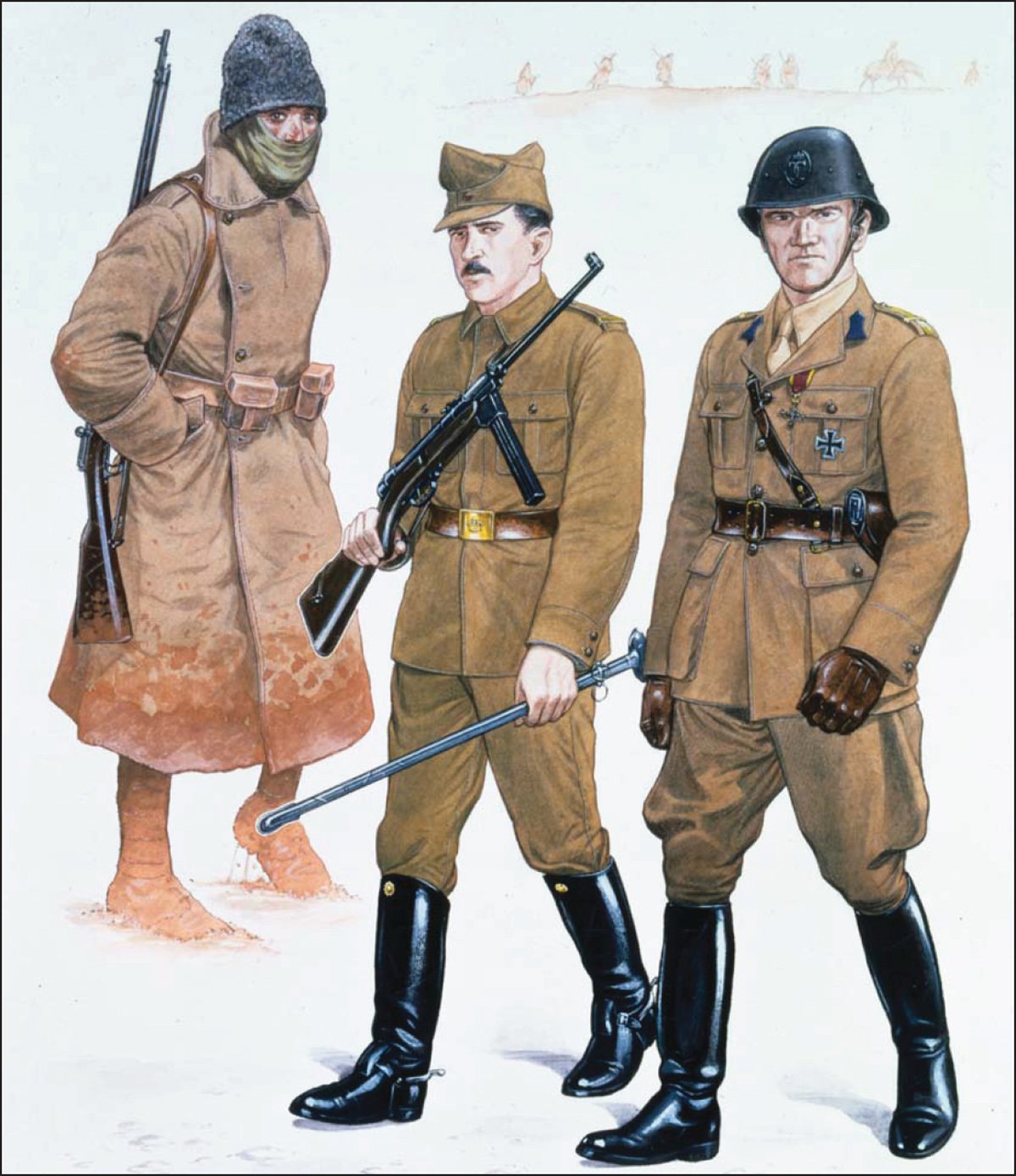
Romanian troops, 1941–42 (L–R): Private, Infantry; Corporal, Cavalry; Captain, Infantry, by Mike Chappell © Osprey Publishing Ltd. Taken from Men-at-Arms 131: Germany’s Eastern Front Allies 1941–45.
As the waters receded from the high water mark at Stalingrad, Romanian loyalties began to shift. With an eye towards Transylvania and other territories often disputed with Hungary, the will to remain an Axis power was quickly leaving the Romanian political landscape. The Romanians fought hard for a while against the Soviet onslaught, but eventually succumbed and joined them in the march west.
A Romanian force for War in Romania must comprise one or more Reinforced Platoons picked from the following theatre selector. Each Reinforced Platoon is made up as follows:
1 Lieutenant – First or Second
2 Infantry sections – Late War infantry, Motorized infantry
Plus:
Headquarters
0–1 Captain or Major
0–1 Medic team
0–1 Forward Observer (Artillery)
Infantry
0–4 Infantry sections: Late War infantry, Motorized infantry, Cavalry
0–1 Machine gun team
0–1 Sniper team
0–1 Panzerschreck team
0–1 Mortar team: light, medium or heavy
Artillery
0–1 gun from:
Anti-tank gun: 7.5cm PaK 97/38, 75mm TAC Resita anti-tank gun
Field artillery: light artillery, medium artillery, heavy artillery
Anti-aircraft gun: light or heavy automatic cannon
Armoured Cars and Recce Vehicles
0–1 vehicle from: SdKfz 222 or 223
Tanks and Tank Destroyers
0–1 vehicle from: Panzer 35(t), Panzer 38(t), captured Renault R35, Tacam tank destroyer, Panzer IV G or H, Panther A or G, StuG III G
Transports and Tows
0–1 transport vehicle per infantry unit in the Reinforced Platoon: miscellaneous trucks
0–1 tow: artillery tractor
• Axis Vehicles in Romanian Service: The Germans provided the Romanian army with many left over armoured fighting vehicles, significantly bolstering the Romanian armoured forces. You may use any of the following vehicles from either the Armies of Germany book or the Bolt Action main rulebook. These vehicles may be purchased at any of the training levels available to the Germans.
• Tanks: Panzer 35(t) or Panzer 38(t), Panzer III N, Panzer IV E, F, G, or H, StuG III G, Panther A or G
• Armoured Cars: SdKfz 222, SdKfz 223
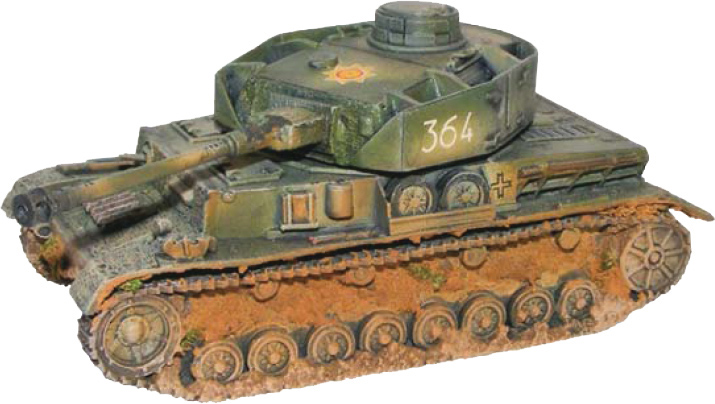
Romanian Pz IV ausf H